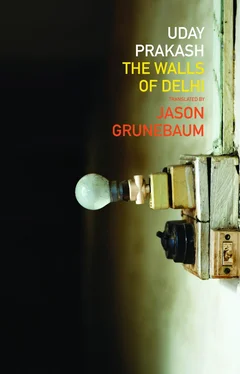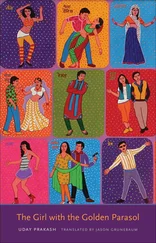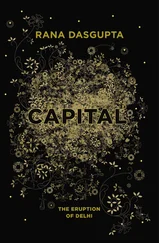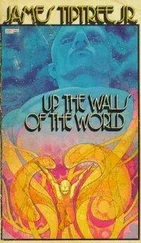I asked him to tell me all about it, and he did; and now I’ve told you everything he told me. When he finished, just as I was about to see if I could find some way to help — Sushma showed up.
‘Meet me here tomorrow morning. I’ve got to go,’ Ramnivas said, and the two of them jumped in a rickshaw. I watched them ride away until I couldn’t see them any longer. That was the last time I saw Ramnivas.
He won’t come back to this little corner of the street. He’ll never come back. If you ask anyone about him, no one will say a word: not Sanjay, not Ratan Lal, not Devi Deen, not Santosh, and not Madan.
And if you keep going from this corner to the sixteenth century ruins at the bypass, and ask Saliman, Somali, Bhusan, Tilak, or Rizvan about Ramnivas, you’ll get the same blank stare. Ask Rupna Mandal, the one-eyed girl who sells paper flowers and pinwheels, whose face is blanketed with white spots from vitiligo, or Rajvati and her husband Gulshan, who sell hard-boiled eggs at night — they’ll all give you the brush-off.
Even the fair and graceful Sushma, who comes every day from Samaypur Badli to clean people’s homes, will walk right past you at a brisk pace without so much as a word. That’s how bad it is. Nowadays, she’s been seen taking excursions in auto rickshaws with Santosh, the motor scooter mechanic. I saw the two of them munching on chat and papri in front of the Sheela Cinema last week.
That’s how life goes on.
And if you happen to travel to that little settlement by the sewage runoff in Samaypur Badli and manage to ask for the address of the tiny hut that Ramnivas had converted into a real house, and, once there, ask his wife, Babiya, or his sickly son, Rohan, or his daughter, Urmila, Where is Ramnivas? you’ll face a stare as blank and cold as stone. They’ll say, He’s not home. He’s out of town. If you ask when he’ll be back, Babiya will reply, ‘How should I know?’ and walk back inside.
In the New Delhi Municipal Office in Saket, where Ramnivas used to work, go and ask Chopri sahib or some other worker about a man by the name of Ramnivas, and they’ll tell you, ‘How are we supposed to remember the names of the hundreds of daily wage workers who come through here every day?’
No one in all of Delhi has any idea about Ramnivas — that much is clear. He simply doesn’t exist anywhere — no trace is left. But hold on a minute. I’m about to give you the final facts about him. That’s why I’ve used this story as a cover, so you can find the secret behind.
If you read any of the Hindi or English newspapers that come out in Delhi — say, Indian News Express, Times of Metro India, or Shatabdi Sanchar Times — and opened the June 27 2001 edition to page three, where they stick the local news, you’d see a tiny photograph two columns wide on the right side of the page. Below the photo, in twenty point boldface, the headline of the capsule news item reads: Robbers Killed In Encounter, and below that, in sixteen point font, the subheader: Police Recover Big Money From Car.
The three-line capsule was written by the local crime reporter, according to whom, the night before, near Buddha Jayanti Park, the police stopped a Suzuki Esteem that bore no licence plates, and was travelling on Ridge Road from Dhaula Kuan to Rajendra Nagar and Karol Bagh. Instead of stopping, the people inside the car opened fire. The police returned fire, and two of the criminals were killed on the spot, while three others successfully fled in the dark of night. One of the dead was Kuldip aka Kulla, a notorious criminal from Jalandhar. The other dead man could not be identified. Police Assistant Superintendent Sabarwal said that two point three million rupees were recovered from the trunk of the car, most of which were counterfeit five-hundred-rupee bills. It was the biggest police haul in many years. The Assistant Superintendent stressed the importance of information provided by the Agra police in netting the loot.
If you were to examine the photo printed above this news item, you’d notice that the car is parked right in front of Buddha Jayanti Park. The front and back doors are open. One of the men is lying face down next to the front tire, and he’s wearing a Sikh pagri on his head. And the dead man lying right beside the back door seems to be staring up at the sky. Look closer — use a magnifying glass if you have one, or, better yet, enlarge the photo.
The dead man lying face up in the street next to the back door of the car, mouth open, pants coming undone and shirt unbuttoned, chest riddled with bullet holes from the police, is none other than Ramnivas — the criminal who, to this day, remains unidentified. And he will never be identified, since no one would recognise him any longer. THE REVEALING OF THE SECRET, A CROWBAR, A TROWEL, AND AULIYA’S SHRINE
Now, listen to what happened that day, a few hours before the encounter.
According to Govind, who sells chai on the street corner in front of A-11/DX33, Saket, that night at ten, a police Gypsy came with three plain-clothes cops and two regular ones. They went into the gym, kicked out all the girls and boys who were exercising, and then, later, themselves left. About an hour later, as Govind was closing his stall, the Esteem pulled up. It didn’t have any licence plates, and a Sikh, not too tall, not too short, got out.
Ramnivas stepped out of the backseat right after him. They went inside and stayed for about an hour and a half. They kept carrying things from the building and loading them into the back seat and boot of the vehicle. An undercover Ambassador car with concealed sirens pulled up right around the corner, where Khanna Travels and Couriers shop is, and followed the Esteem when it began to pull away.
Govind’s shop was closed — he was getting ready to go home — when the greenish Esteem without licence plates pulled up right next to him. Ramnivas rolled down the window and asked for a bidi. Govind had an open, half-smoked pack of Ganesh brand bidis in his shirt pocket, and gave him what he had.
Govind said Ramnivas looked incredibly stressed, his eyes glazed over like those of a corpse. He’d tried to say something to him, but the Esteem was gone in a flash — the Sikh was driving.
If you’re at Dhaula Kuan crossing and instead of taking Ring Road, take the next left, Ridge Road, you’ll run into Buddha Jayanti Park. It’s right off Ridge Road, and that’s where the photo was taken.
According to what Ramnivas told me about the hollow wall in the gym at Saket, it must have been pretty large. Conservatively, I figured, it had to have enclosed an area of about twelve by four feet. Ramnivas had said the space was crammed full of one hundred and five-hundred-rupee bills. Based on that, I did the maths. What I came up with was that there was easily anywhere from a hundred to a hundred and fifty million rupees in there.
Do you remember the case where the Central Bureau raided a cabinet minister’s house, along with a few of his other properties? The investigation was launched by the government that had just come into power, and the cabinet minister under investigation had been part of the previous government. The minister was charged with taking something like a billion rupees in kickbacks from some foreign company that supplied sophisticated high-tech equipment. The man did a little time, and was later released. He then joined the very same government that had earlier begun the investigation. It’s clear that Ramnivas, guided by auspicious astrological alignments, or just dumb luck, had discovered a problem with his broom, and, in order to solve it, he began banging the broom head against the wall. He figured out the wall was hollow, put his hands inside, and was suddenly face-to-face with money hidden from the eyes of the Central Bureau and from the tax man. It was unaccounted money, untraceable money — dirty money.
Читать дальше










